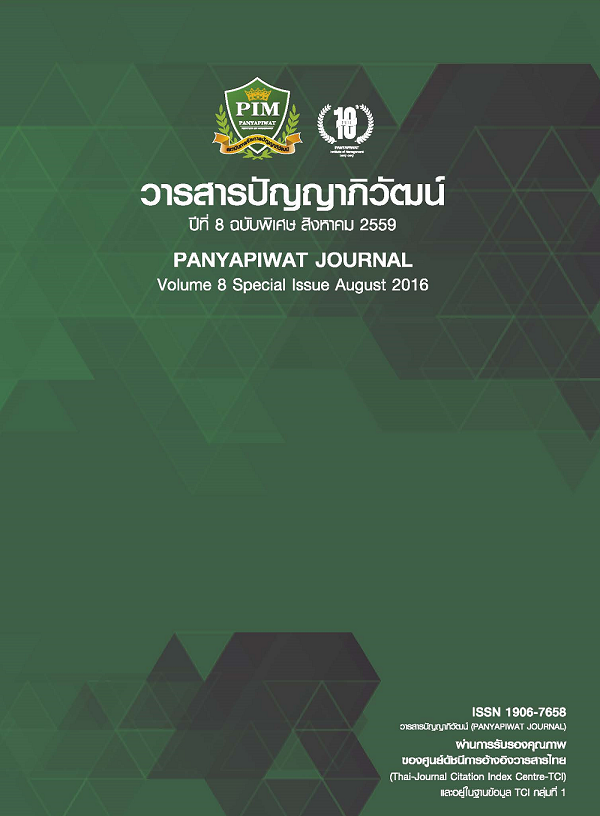MOTIVATION THEORY, COMMUNICATIVE LANGUAGE TEACHING (CLT) AND ENGLISH AS A GLOBAL LANGUAGE APPLYING WITH TASK AND PROJECT ASSIGNED CONCERNING WITH SOME OCCUPATIONS IN ASEAN ECONOMIC COMMUNITY (AEC)
Main Article Content
บทคัดย่อ
The article aims to share idea and to suggest the way to teach English, design activities to motivate students for learning. With reference to the writer’ teaching experience, he has known the students’ problems in which the students do not have motivation to speak English, it is affected by their traditional learning. Moreover, the students only learn English by remembering the dialogue from the teachers but they have less chance to design their role and their speech according to their ideas. Hence, this academic article aims to share teaching experiences by teaching undergraduate students and promoting motivation theory: intrinsic and extrinsic motivation, Communicative Language Teaching (CLT) and knowledge of English as a global language to apply in English Language Teaching (ELT) in order to change the students’ English learning attitude. By applying the theories, the students have motivation to learn English by themselves as autonomous learners and they pay more attention to find information about dialogues of English conversation and English lesson outside classroom. The author also designed course syllabus and assigned travelling task and the exhibition “International English Fun Fair & Festival in teaching English.
บทความนี้มีวัตถุปรสงค์เพื่อเสนอความคิด แนะนำวิธีการสอนภาษาอังกฤษ การออกแบบกิจกรรมเพื่อกระตุ้นนักเรียนเพื่อการเรียนร้ โดยอ้างอิงถึงประสบการณ์การสอนของผู้เขียนแล้ว ผู้เขียนรู้ว่าปัญหาของนักศึกษาคือ การที่ตัวนักศึกษาเองไม่มีแรงกระตุ้นในการพูดภาษาอังกฤษ ซึ่งเป็นผลกระทบมาจากการเรียนรู้แบบเก่า นอกจากนั้นนักศึกษาเพียงแต่เรียนภาษาอังกฤษโดยการจดจำบทพูดจากอาจารย์ แต่นักศึกษาก็มีโอกาสที่จะออกแบบบทบาทและบทพูดที่เป็นความคิดของตนเอง ดังนั้น บทความวิชาการนี้จึงมีวัตถุประสงค์เพื่อเป็นการนำเสนอประสบการณ์การสอน โดยการสอนนักศึกษาระดับปริญญาตรีและนำเสนอทฤษฎีแรงกระตุ้น (แรงกระตุ้นภายในและภายนอก), การสอนภาษาอังกฤษเพื่อการสื่อสาร และความรู้ในเรื่องของภาษาอังกฤษในฐานะเป็นภาษาโลกโดยนำมาประยุกต์ใช้ในการสอนภาษาอังกฤษเพื่อปรับเปลี่ยนทัศนคติในการเรียนภาษาของนักศึกษา โดยการประยุกต์ทฤษฎี นักศึกษาจะมีแรงกระตุ้นในการเรียนภาษาเยื่ยงผู้ที่เรียนรู้ด้วยตนเอง และนักศึกษายังให้การทุ่มเทในการค้นหาข้อมูลเกี่ยวกับบทสนทนาและบทเรียนภาษาอังกฤษนอกชั้นเรียน ผู้เขียนจึงออกแบบหลักสูตรและมอบหมายงานเกี่ยวกับการเดินทางและทางฝ่ายภาษาอังกฤษจึงมีนิทรรศการ “เทศกาลการความสนุกสนานของภาษาอังกฤษในฐานะเป็นภาษานานาชาติ” เข้ามาในการสอนภาษาอังกฤษ
Article Details
“ข้าพเจ้าและผู้เขียนร่วม (ถ้ามี) ขอรับรองว่า บทความที่เสนอมานี้ยังไม่เคยได้รับการตีพิมพ์และไม่ได้อยู่ระหว่างกระบวนการพิจารณาลงตีพิมพ์ในวารสารหรือแหล่งเผยแพร่อื่นใด ข้าพเจ้าและผู้เขียนร่วมยอมรับหลักเกณฑ์การพิจารณาต้นฉบับ ทั้งยินยอมให้กองบรรณาธิการมีสิทธิ์พิจารณาและตรวจแก้ต้นฉบับได้ตามที่เห็นสมควร พร้อมนี้ขอมอบลิขสิทธิ์บทความที่ได้รับการตีพิมพ์ให้แก่สถาบันการจัดการปัญญาภิวัฒน์หากมีการฟ้องร้องเรื่องการละเมิดลิขสิทธิ์เกี่ยวกับภาพ กราฟ ข้อความส่วนใดส่วนหนึ่งและ/หรือข้อคิดเห็นที่ปรากฏในบทความข้าพเจ้าและผู้เขียนร่วมยินยอมรับผิดชอบแต่เพียงฝ่ายเดียว”
References
Barber, C. (1999). The English language: a historical introduction. The Germanic language. Cambridge: Cambridge University Press.
Benabou, R. & Tirole, J. (2003). Intrinsic and Extrinsic Motivation. The Review of Economic Studies, 70(3), 489-520.
Brown, H. D. (1994). Principles of language learning and teaching. New York. Addison Wesley Longman.
Bush, J. (2004). A rationale for task-based learning. Faculty of management information sciences. Japan: Job university. Shimmachi Gumma.
Cherry, K. (2014). Theories of Motivation. A Closer Look at Some Important Theories of Motiva-tion. Retrieved January 31, 2014, from http://en.wikipedia.org/wiki/Motivation#Intrinsic_and_Extrinsic_motivation
Crystal, D. (1997). English as a global language. Cambridge: Cambridge University Press.
Dickinson, L. (2002). Enhancing Motivation for Language Learning. LNG 521. Thailand: King Mongkut’s University of Technology Thonburi.
Doughlas B. H. (1987). Motivation Principles of Language Learning and Teaching. Englewood Cliffs, NJ: Prentice-Hall.
Ellis, R. (2004). Task based language learning and teaching. Oxford: Oxford university press.
Gardner, R. C. & Lambert, W. E. (1972). Motivation in second and foreign language learning. Retrieved April 10, 2014, from www.zoltandornyei.co.uk/uploads/1998-dornyei-lt.pdf
Hymes, D. (1972). On Communicative Competence, in Pride, J. B. & Homes, J. (eds). Sociolinguistics. Harmondsworth: Penguin.
Inthapat, C. (2011). Language used in 7-Eleven Convenient Store and Using Communicative Approach for Students at Panyapiwat Institute of Management. Panyapiwat Journal, 2(2), 28-41.
Jackeline, R. & Castaneda, P. (2013). Englishteaching through project based learning method in rural area. Retrieved May 18, 2016, from http://www.scielo.org.co/pdf/clin/n23/n23a09.pdf
Larmer, J., Mergendoller J. & Boss, S. (2015). Gold standard PBL: Essential project design elements.Retrieved May 18, 2016, from http://bie.org/blog/gold_standard_pbl_essential_project_design_elements
Manzoor, F., Ahmed, M. & Gill, B, R. (2015). Use of Motivational Expressions As Positive Reinforcement In Learning English At Primary Level In Rural Areas Of Pakistan. International Journal of English Language Teaching, 2(3), 30-42.
Raffini, J. (1993). Memory, Comprehension and Motivation. LNG 521. Faculty of Liberal of Arts, King Mongkut’s University of Technology Thonburi.
Richards, J. C. & Rodgers, T. S. (1986). Approaches and methods in language teaching. Cambridge: Cambridge University Press.
Saraceni, M. (2002). English as a world language: Institute of English Language Education. MA. ELT, Assumption University.
Widdowson, H. G. (2003). English as an international language. Defining Issues in English Language. Oxford: Oxford University Press.
William, L. (1981). Communicative language teaching: An introduction. Cambridge: Cambridge University Press.
Woolfolk, A. E. (1993). What is Motivation?. Educational Psychology. LNG 521. Faculty of Liberal Arts, King Mongkut’s University of Technology Thonburi.

